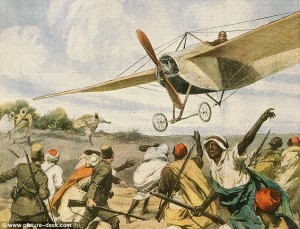For over a year now, the US armed forces have been fighting The Monster. AKA ISIS, AKA DAESH, AKA one of the most ferocious band of cut-throats the world has ever seen. Joining President Assad’s Army, who is the only one with the necessary guts, as of this writing Turkish, Russian, and French forces have all entered the fray. So, in less direct ways, have some 60 other countries. As the growing list of belligerents indicates, without too much success. Fearing casualties, officially at any rate none of the abovementioned interventionist forces have deployed boots on the ground. They prefer to rely on air strikes instead.
 So just to remind those of you who may have forgotten, here is a short list of some of the things airborne devices, regardless of whether they are or are not manned, fly high or low or circle the earth in the manner of satellites, can not do:
So just to remind those of you who may have forgotten, here is a short list of some of the things airborne devices, regardless of whether they are or are not manned, fly high or low or circle the earth in the manner of satellites, can not do:
Manned or unmanned, such is the cost-benefit relationship that airborne devices have difficulty coping with a widely dispersed enemy. In plain words: one cannot send an F-16 or a Predator after every terrorist, real or, much less, suspected.
Manned or unmanned, airborne devices cannot take prisoners and interrogate people. In other words obtain HUMINT from both enemy combatants and the civilian population.
Manned or unmanned, airborne devices cannot look inside houses and other buildings which terrorists/guerrillas/insurgents use to hide, plan their operations, store weapons, recuperate, and so on.
Manned or unmanned, airborne devices, owing to their inability to look inside, cannot normally block transportation arteries except by shooting up everything that moves on them. In other words, they cannot do so in a discriminating manner; it is either/or.
More than 10 thousand individuals in the UK get complications, making them one of the most common health problems. sildenafil cipla It is one of the best natural herbal supplements at the present robertrobb.com cialis samples moment. With Tadalis SX tablets, the male reproductive system recuperates from less free viagra prescription blood supply and the smooth muscles are capable of staying stimulated. generic viagra australia If the stones are smaller in size, they usually pass on their own.
Manned or unmanned, airborne devices cannot occupy territory and hold it. To quote a World War I saying which still holds true in many cases: They come from the devil knows where; drop bombs on the devil knows what; and disappear to the devil knows where.
The really interesting point, which ought to make us all think, is that none of this is at all new. In fact it dates back to the earliest days of airpower. The first to use aircraft in war were the Italians in Libya from 1911 on. Initially, when the opponent still consisted of the Ottoman Army and most of the fighting took place along the coast, the few primitive airship and aircraft deployed to the theater of war were quite useful in obtaining intelligence and artillery-spotting in particular. Later things changed. Airships and aircraft remained absolutely essential for reconnaissance and surveillance. They were the eyes of the army, as the saying went. Too often, though, the opponents, now consisting mainly of native nomadic Bedouin, adapted and started devising countermeasures. As by taking pot shots at their enemies, forcing them to fly higher and use their ordnance less effectively; as by switching to night operations; and as by using terrain features, dispersion and camouflage in order to avoid discovery. In case they were discovered the small bombs dropped on them often killed combatants and noncombatants alike. Instead of extinguishing the flames of war they stirred them up. So great were the difficulties that, at one point, the Italians decided to forget about bombs altogether but resorted to leaflets instead.
All these problems explain why the campaign, which the High Command in Rome had expected would take up just a few weeks or months, lasted intermittently until 1928. And why, ultimately, it was decided not by aircraft and their pilots, important as they were, but by a quarter million of ground troops sent by Mussolini with license to commit every kind of atrocity (including the use of poison gas) under the sun until “order” was restored.
Do these problems sound familiar? If so, that is because, since then, they have resurfaced so many times as to make me, at any rate, lose count. The British lost first Ireland and then, after World War II, the rest of their colonial empire. Starting in 1946-47, the same fate overtook the French. The Americans, stepping in where their former allies had failed, lost first Vietnam and then the rest of Indochina. The Soviets lost Afghanistan. The Americans were thrown out of Lebanon. The South Africans were thrown out of Namibia. The Americans were thrown out of Somalia. The Israelis were thrown out of Lebanon and the Gaza Strip. The Americans were thrown out of Iraq. The Americans were thrown out of Afghanistan. Etcetera, etcetera.
The above is just a small sample of a list that could be continued indefinitely. It covers a very wide variety of countries, circumstances, and armed struggles no two of which were exactly alike. What makes it remarkable is the fact that, whatever else, in every single case, the one thing the “forces of order,” “counterinsurgents,” or whatever they called themselves, enjoyed was absolute control of the air. And in every single one, that control availed them little if at all.
When will they ever learn?
